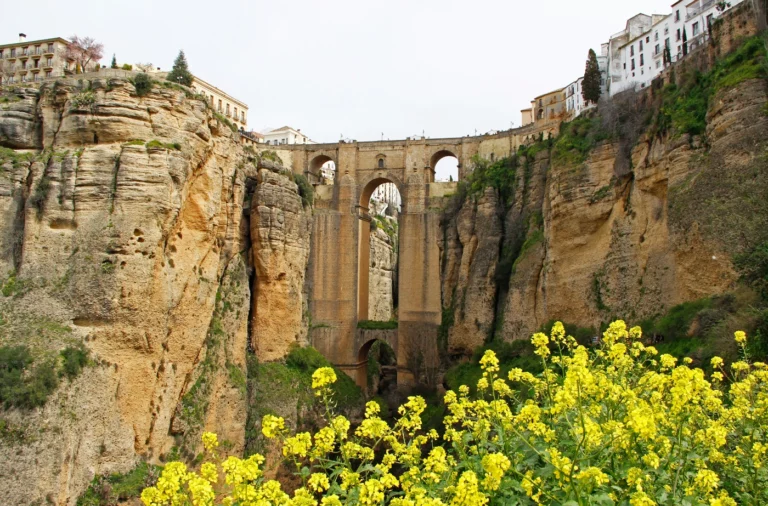Ronda, a breathtaking city perched atop a sheer gorge in Andalusia, Spain, boasts a rich history that dates back to the ancient Iberian peoples. Throughout the centuries, it has witnessed the rise and fall of civilizations, leaving behind an eclectic blend of architectural wonders and cultural traditions. If you’re planning a visit in April 2024, here are seven amazing places that you won’t want to miss:
1. The Puente Nuevo (New Bridge)
Spanning the Tajo de Ronda gorge at a height of 390 feet, the iconic Puente Nuevo is Ronda’s most famous landmark. Completed in 1793 after a previous bridge collapsed, this magnificent structure connects the city’s old and new quarters and offers breathtaking views of the surrounding countryside. Take a leisurely stroll across the bridge, soak in the panoramic vistas, and marvel at the engineering prowess that brought this architectural masterpiece to life.
2. The Plaza de Toros (Bullring)
Ronda is renowned for its bullfighting tradition, and its historic Plaza de Toros is one of the oldest and most elegant bullrings in Spain. Built in 1785, it is considered a masterpiece of neoclassical architecture and has hosted some of the most famous toreros in history. Even if you’re not a fan of bullfighting, the arena is worth visiting for its historical significance and architectural beauty. Take a guided tour to learn about the history of bullfighting in Ronda and marvel at the exquisite craftsmanship of the plaza.
3. The Arab Baths
Step back in time and immerse yourself in the grandeur of the Arab Baths, a testament to Ronda’s Moorish heritage. Built in the 13th century, these subterranean baths were used for centuries by the local Muslim population. The baths feature intricate arches, domed ceilings, and a network of underground chambers, all illuminated by natural light. Take a guided tour to explore the fascinating history of the Arab Baths and experience the tranquility of this ancient spa.
4. The Mondragón Palace
The Mondragón Palace is a magnificent Renaissance palace that once belonged to King Ferdinand and Queen Isabella. Built in the late 15th century, it is a stunning example of Andalusian architecture. The palace boasts intricate stone carvings, beautiful courtyards, and a grand staircase that leads to the luxurious state rooms. Explore the opulent chambers, admire the exquisite artwork, and learn about the palace’s fascinating history.
5. The Church of Santa María la Mayor
This impressive Gothic-Renaissance church stands in the heart of Ronda’s old town. Constructed between the 15th and 17th centuries, it is the largest church in the city. The church features a soaring bell tower, intricate facade, and a stunning altarpiece. Step inside to admire the delicate stained-glass windows, the richly decorated choir stalls, and the breathtaking vaulted ceilings.
6. The El Tajo Gorge
The El Tajo Gorge is a natural wonder that separates Ronda’s old and new quarters. This 390-foot-deep gorge was formed by the Guadalevín River over millions of years and offers breathtaking views of the surrounding countryside. Take a walk along the gorge’s edge, admire the sheer cliffs, and enjoy the scenic vistas. You can also cross the historic Puente Nuevo and soak in the panoramic views from both sides of the gorge.
7. The Ronda Wine Museum
Nestled in the historic center of Ronda, the Ronda Wine Museum offers a fascinating insight into the city’s renowned winemaking tradition. The museum showcases the history, production, and varieties of Ronda wines. Take a guided tour to learn about the different grape varieties, the winemaking process, and the importance of wine in local culture. You can also sample some of the region’s finest wines and take some home as a souvenir.
Culture, Best Months to Visit, Nearby Transportation, Local Food, and Best Hotels
Ronda’s rich cultural heritage is reflected in its vibrant festivals, traditional cuisine, and warm hospitality. The city hosts numerous events throughout the year, including the Feria de Pedro Romero (in September), a lively celebration with bullfights, flamenco dancing, and traditional music.
The best months to visit Ronda are April, May, and October, when the weather is pleasant and the crowds are smaller. The city is well-connected by train and bus to major cities in Spain, making it easy to integrate into your travel itinerary.
Local food in Ronda is based on traditional Andalusian cuisine, featuring fresh produce, seafood, and meats. Don’t miss the local specialties such as “porra antequerana” (a cold tomato soup), “gazpachuelo” (a fish stew), and “migas” (a dish made with breadcrumbs, pork, and vegetables).
For a comfortable stay in Ronda, consider booking a room at one of the charming hotels in the historic center. Some recommended options include Hotel Catalonia Ronda, Parador de Ronda, and Hotel San Gabriel. These hotels offer a perfect combination of comfort, convenience, and historical ambiance.
Conclusion
Ronda is a captivating city that seamlessly blends its rich history, cultural heritage, and natural beauty. As you explore its amazing places in April 2024, you’ll embark on an unforgettable journey that will leave a lasting impression. From the awe-inspiring Puente Nuevo to the enchanting Ronda Wine Museum, Ronda offers a myriad of experiences that will captivate your senses and create memories that will last a lifetime.
